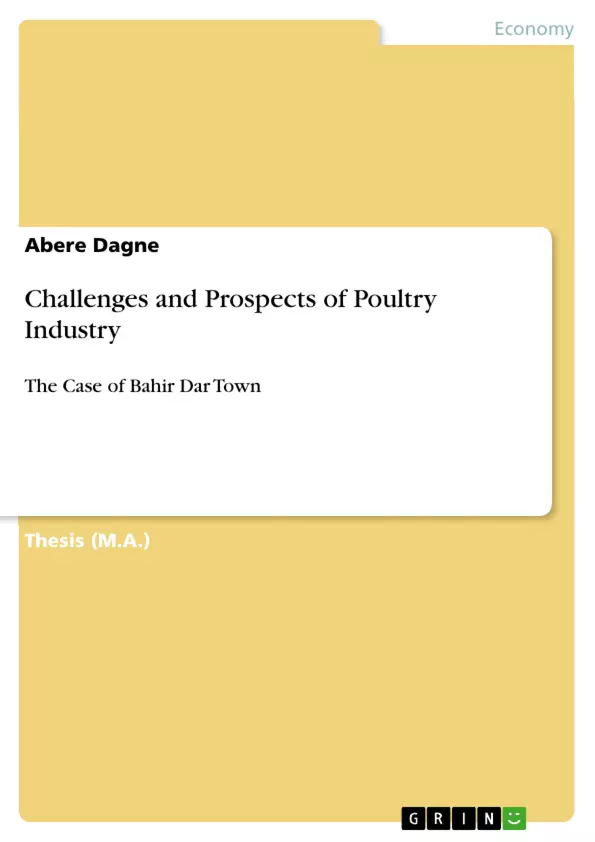In Ethiopia poultry industry plays decisive role to improve income of peoples, especially who lives with low income. Different research on genetics, health, production, and marketing were conducted, though none have done in Bahir Dar City. Less attention has been given to identify challenges and prospects of poultry industry rather than taking one component and react on that, though poultry industry is diminishing through time without clear and research based identified problems. The purpose of this study was to identify the challenges and prospects of poultry industry in Bahir Dar city. What are the major constraints and prospects of poultry industry, what would help strengthen poultry industry, and how do poultry productions profitability look like? These were questions which the study attempts to answer with focus on Bahir Dar city poultry industry. The study was descriptive type of research and the data for the study were collected through sets of questionnaires administered to respondents, as well as interviews, with some selected producers and experts. Census sampling technique was used to select respondents and data collected was analyzed by the use of SPSS and Microsoft Excel. The study revealed that stakeholders involved in the poultry business of Bahir Dar poultry farm industry believe the industry is actually declining and they assign causes such as shortage of guaranteed land, absence of sufficient electric power, absence of genuine breed supply of chicken, lack of knowledge on poultry production, shortage of professionals in the area, government’s lack to amend land lease time policy based on the nature of poultry industry, absence of clear control mechanism of genuine breed poultry and absence of feed processer either private or/and government organization subsidies on agric inputs like feed, drugs, equipment and several other factors. On the other hand, major prospects of poultry industry in Bahir Dar city like presence of good government policy, presence of better market demand and conducive environment for poultry production were identified. It can be concluded that, if the government and producers are unable to overcome those major identified constraints and challenges of poultry industry, the existing loss of poultry industry will be aggravated and most probably poultry industry will be totally eliminated from Bahir Dar city. Finally I recommended the government to revise its land lease policy, to create access genuine breed poultry ...
Inhaltsverzeichnis (Table of Contents)
- ACKNOWLEDGEMENT
- DEDICATION
- ABSTRACT
- ANGRs
- ACRONYMS
Zielsetzung und Themenschwerpunkte (Objectives and Key Themes)
This study aims to identify the challenges and prospects of the poultry industry in Bahir Dar city, Ethiopia. It investigates the key constraints and opportunities facing the industry, exploring factors that could strengthen its development and examining the profitability of poultry production. The research focuses on the specific context of Bahir Dar city, aiming to provide insights into the factors affecting the local poultry industry.
- Challenges and constraints faced by the poultry industry in Bahir Dar.
- Prospects and opportunities for growth and development within the industry.
- Factors influencing the profitability of poultry production in the region.
- The role of government policies and regulations in shaping the industry's future.
- Strategies and recommendations for addressing challenges and maximizing opportunities.
Zusammenfassung der Kapitel (Chapter Summaries)
This section will provide summaries of the chapters in the study, focusing on the main themes, arguments, or narrative elements of each chapter. The summaries will exclude the conclusion or any sections containing major revelations or spoilers.
Schlüsselwörter (Keywords)
The main keywords and focus topics of this study include: poultry industry, challenges, prospects, Bahir Dar city, Ethiopia, poultry production, profitability, government policies, constraints, opportunities, and strategies.
- Quote paper
- Abere Dagne (Author), 2015, Challenges and Prospects of Poultry Industry, Munich, GRIN Verlag, https://www.grin.com/document/296347



